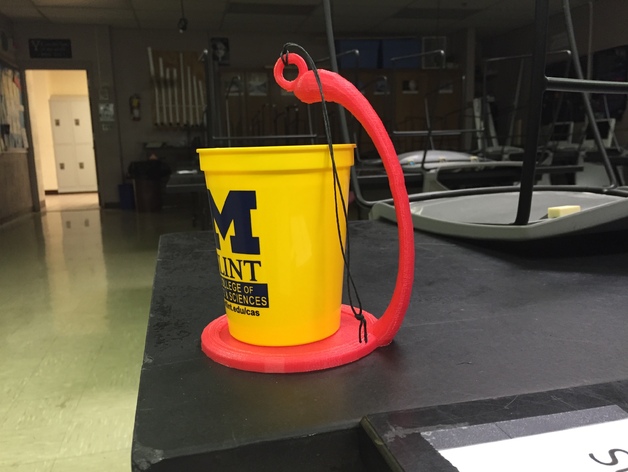
Centripetal Force Demonstrator
thingiverse
I spotted the Centrifugal Mug Carrier by Ecogeeco and decided to see if I could make one myself. It's basically identical to the SpillNot from Arbor Scientific. The dimensions are designed to fit a standard coffee cup (83 mm diameter, 110 mm tall). To use it, tie a string or strap to the ring. Now, you put a full cup of water or a mug of coffee in this contraption and swing it around without spilling a single drop - unless you hit someone with it. With some practice, you can even swing it in big vertical circles over your head or horizontal circles above you. Here are my print settings: Rafts: None needed Supports: Yes, they were essential Resolution: 0.3 Infill: 40% for added strength I printed mine using PLA with three perimeters and 40% infill to ensure the neck was strong enough while swinging this thing in big circles over my head. This project originated on TinkerCad where I can easily modify it to suit whatever cup you might have. Here's a breakdown of what I created: A "Cylinder" (orange) as the base with a squished "Torus thin" (red) to form a lip that prevents things from sliding off. A "Torus" (green) is above the center of the base, floating in space. It must be centered directly above the base at your desired height for this to work. Group it with the base so it stays perfectly aligned. To connect these two pieces, I stretched a "Torus Thin" (blue) and used "Box" holes to remove any unnecessary parts. To give it a nicer look, I tacked on a "Half Sphere" which is not visible in this image but is hidden below. This was designed for the classroom with an assignment that encourages students to create devices that aid in science education, either by recreating existing products or imagining new ones from scratch. In the process, they'll learn about the scientific principles involved and constraints of 3D design and printing. If copying a design online, students will be tasked with proposing improvements. The objectives of this assignment are: - Students can demonstrate devices that teach/learn science concepts - They can create and print basic 3D designs - Evaluate designs and propose improvements Target audiences include grades 6-12, focusing on science or engineering students. Skills/Standards: NGSS Engineering standards and specific Science Standards depending on the chosen problem. NGSS Core Ideas: Engineering: Defining and Delimiting an Engineering Problem Engineering: Developing Possible Solutions Engineering: Optimizing Design Solution Science Standards: These will vary based on the specific problem solved by the students. Lesson Plan: Introduction to Tinkercad for 3D printing. Share interesting student creations with class and discuss 3D printing limitations/capabilities. Will this design be printable? Do support requirements exist? Should it be printed in parts and then assembled? Introduce Assignment: Create a device to help teach science concepts. You can take inspiration from an existing product or create your own. Duration: 1 Class period: Introduce Tinkercad and have students create a simple thing 1 Class period: Share designs, discuss 3D printing, and introduce the assignment. 1 Class period for students to research/brainstorm ideas 2 Class periods to design models in TinkerCad 1 Class period for testing/demoing 2 Class periods to improve or redesign their creations.
With this file you will be able to print Centripetal Force Demonstrator with your 3D printer. Click on the button and save the file on your computer to work, edit or customize your design. You can also find more 3D designs for printers on Centripetal Force Demonstrator.
